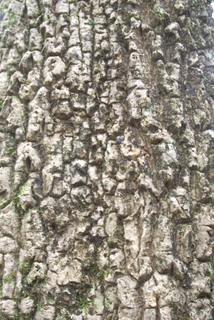Soft corkwood facts for kids
Quick facts for kids Soft corkwood |
|
|---|---|
 |
|
| Corky bark of Caldcluvia paniculosa at Mount Banda Banda, Willi Willi National Park, Australia | |
| Scientific classification | |
| Genus: |
Caldcluvia
|
| Species: |
paniculosa
|
| Synonyms | |
The Caldcluvia paniculosa, also known as the soft corkwood, is a special rainforest tree found in eastern Australia. You can find it growing from Ourimbah in New South Wales all the way up to Eungella National Park in tropical Queensland.
This tree has a few other common names too, like corkwood, rose-leaf marara, brown alder, and sugarbark. Scientists sometimes call it Ackama paniculosa instead, which shows how its name has changed over time.
You'll often spot the soft corkwood in different types of rainforests. These include forests near rivers, along the coast, or in tropical, subtropical, and warm temperate areas. It can also grow where eucalyptus forests meet rainforests. A great way to spot this tree is by its bark, which feels unusually soft and cork-like.
Contents
What Does the Soft Corkwood Tree Look Like?
The soft corkwood is a medium to large tree. It can grow very tall, sometimes over 40 metres high! Its base often has wide, strong supports called buttresses. The trunk is usually straight and round.
Bark and Trunk
The bark of this tree is one of its most unique features. It's soft and feels like cork. The color is usually a greyish-fawn. The bottom of the tree often has large, wide supports, which help it stay stable.
Leaves and Flowers
The leaves of the soft corkwood are interesting. They grow in groups, usually with five to seven smaller leaflets, but sometimes just three. These leaves are a bit hairy and have jagged edges, like tiny teeth. Each leaf can be between 5 and 12 centimetres long.
In November, the tree gets beautiful creamy-white flowers. These flowers grow in large, branched clusters called panicles.
Fruit and Seeds
After the flowers, the tree produces small red fruits. These fruits are like tiny capsules. Inside each capsule, you'll find a few small, flat, oval seeds. The seeds are only about 1 millimetre long and have tiny hairs on them. The fruit ripens between February and June.
How Scientists Name the Soft Corkwood
The scientific name of the soft corkwood tree has a bit of a complicated story! Scientists try to give every plant a unique name. This helps everyone know exactly which plant they are talking about.
The Naming Journey
The first time this tree was officially described was in 1860 by a scientist named Ferdinand von Mueller. He called it Weinmannia paniculata. But it turned out that name was already used for a different tree from Chile!
So, in 1861, Mueller gave it a new, correct name: Weinmannia paniculosa. This became the "base name" for the tree. Later, other scientists tried to move the tree into different groups (genera). Sometimes, they made small mistakes with the names, which made things confusing.
Current Scientific Name
In 1979, a scientist named Ruurd Dirk Hoogland moved the tree to the group Caldcluvia. He correctly used the name Caldcluvia paniculosa. Even though some scientists suggested moving it back to the Ackama group more recently, most plant lists today, like The Plant List and the Australian Plant Census, still keep it in the Caldcluvia group. This means Caldcluvia paniculosa is the most accepted scientific name for the soft corkwood tree right now.

